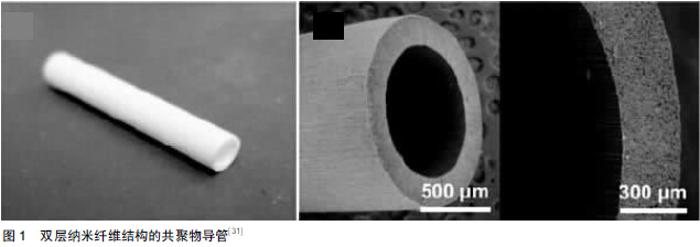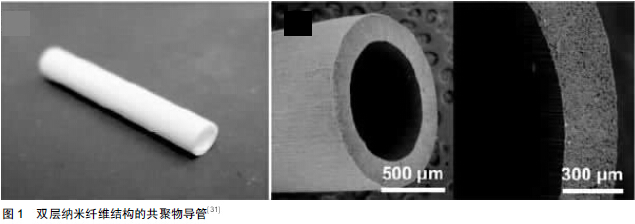Chinese Journal of Tissue Engineering Research ›› 2015, Vol. 19 ›› Issue (43): 7035-7040.doi: 10.3969/j.issn.2095-4344.2015.43.027
Previous Articles Next Articles
Application of tissue engineering scaffolds in neural repair
Han Qian-qian1, Wang Peng-rui2, Wang Chun-ren1, Yang Zhao-peng1, Wang Hong2
- 1National Institutes for Food and Drug Control, Beijing 100050, China; 2the Second Affiliated Hospital of Dalian Medical University, Dalian 116044, Liaoning Province, China
-
Received:2015-06-24Online:2015-10-15Published:2015-10-15 -
Contact:Corresponding author: Wang Chun-ren, Researcher, National Institutes for Food and Drug Control, Beijing 100050, China Corresponding author: Yang Zhao-peng, Chief pharmacist, National Institutes for Food and Drug Control, Beijing 100050, China Corresponding author: Wang Hong, Chief physician, the Second Affiliated Hospital of Dalian Medical University, Dalian 116044, Liaoning Province, China -
About author:Han Qian-qian, M.D., National Institutes for Food and Drug Control, Beijing 100050, China Wang Peng-rui, Studying for master’s degree, the Second Affiliated Hospital of Dalian Medical University, Dalian 116044, Liaoning Province, China Han Qian-qian and Wang Peng-rui contributed equally to this work. -
Supported by:the Strategic Pilot Projects of Chinese Academy of Sciences, No. XDA01030504, XDA01030503
Cite this article
Han Qian-qian, Wang Peng-rui, Wang Chun-ren, Yang Zhao-peng, Wang Hong. Application of tissue engineering scaffolds in neural repair[J]. Chinese Journal of Tissue Engineering Research, 2015, 19(43): 7035-7040.
share this article
|
[1] Kou YH,Yin XF,Zhang PX,et al.Small-gap bridging technology for peripheral nerve injury repair and the new sleeve material. Beijing Da Xue Xue Bao. 2011;43(5):647-651.
[2] Zhang PX,Kou YH,Han N,et al.Clinical effect observation of biodegradable conduit small gap tublization repairing peripheral nerve injury. Beijing Da Xue Xue Bao.2012; 44(6):842-846.
[3] Zhang PX,An S,Wang GQ,et al.Pain assessment of biological conduit small gap tubulization in rat sciatic nerve multilation model. Beijing Da Xue Xue Bao.2013;45(5): 675-678.
[4] 朱国臣,肖大江,娄卫华.去细胞异体神经桥接面神经缺损的实验研究[J].中华创伤杂志,2005,21(11):54-56.
[5] 衷鸿宾,卢世璧,侯树勋,等.去细胞神经同种异体移植的运动功能恢复.中华创伤杂志,2002,18(9):20-222.
[6] 衷鸿宾,卢世璧,侯树勋,等.犬化学去细胞神经同种异体移植的神经电生理研究[J].骨与关节损伤杂志,2003,18(1):30-32.
[7] 梁安霖.复合gdnf和vegf质粒的异体脱细胞神经支架对大鼠坐骨神经缺损的修复作用[D].重庆医科大学,2006.
[8] 张旭,才艳红,贾桦,等.异种神经脱细胞移植物修复周围神经缺损的实验研究[J].解剖科学进展,2007,13(1):46-48,98.
[9] 何红云,邓仪昊,朱建华,等.异种脱细胞神经移植物修复坐骨神经缺损的实验研究[J].实用医学杂志,2011,27(24):4392-4395.
[10] 谢会斌.异种生物型神经导管修复周围神经缺损的实验研究[D]. 广州中医药大学,2009.
[11] Cullen DK,Tang-Schomer MD,Struzyna LA,et al.Microtissue engineered constructs with living axons for targeted nervous system reconstruction. Tissue Eng Part A.2012;18(21-22): 2280-2289.
[12] Liu T,Houle JD,Xu J,et al.Nanofibrous collagen nerve conduits for spinal cord repair.Tissue Eng Part A.2012;18(9-10): 1057-1066.
[13] Zaminy A,Shokrgozar MA,Sadeghi Y,et al.Mesenchymal stem cells as an alternative for Schwann cells in rat spinal cord injury.Iran Biomed J.2013;17(3):113-122.
[14] East E,de Oliveira DB,Golding JP,et al.Alignment of astrocytes increases neuronal growth in three-dimensional collagen gels and is maintained following plastic compression to form a spinal cord repair conduit.Tissue Eng Part A.2010; 16(10):3173-3184.
[15] Han Q,Sun W,Lin H,et al.Linear ordered collagen scaffolds loaded with collagen-binding brain-derived neurotrophic factor improve the recovery of spinal cord injury in rats.Tissue Eng Part A.2009;15(10):2927-2935.
[16] Ghaznavi AM,Kokai LE,Lovett ML,et al.Silk fibroin conduits: a cellular and functional assessment of peripheral nerve repair. Ann Plast Surg.2011;66(3):273-279.
[17] Mottaghitalab F,Farokhi M,Zaminy A,et al.A biosynthetic nerve guide conduit based on silk/SWNT/fibronectin nanocomposite for peripheral nerve regeneration. PloS One.2013;8(9): e74417.
[18] Sharp KG,Dickson AR,Marchenko SA,et al.Salmon fibrin treatment of spinal cord injury promotes functional recovery and density of serotonergic innervation.Exp Neurol.2012; 235(1):345-356.
[19] Johnson PJ,Parker SR,Sakiyama-Elbert SE.Controlled release of neurotrophin-3 from fibrin-based tissue engineering scaffolds enhances neural fiber sprouting following subacute spinal cord injury.Biotechnol Bioeng.2009;104(6):1207-1214.
[20] Gao M,Lu P,Bednark B,et al.Templated agarose scaffolds for the support of motor axon regeneration into sites of complete spinal cord transection.Biomaterials.2013;34(5): 1529-1536.
[21] do Nascimento-Elias AH,Fresnesdas BC,Schiavoni MC,et al.Identification of adequate vehicles to carry nerve regeneration inducers using tubulisation.BMC Neurosci.2012; 13:100.
[22] Ezra M,Bushman J,Shreiber D,et al.Enhanced femoral nerve regeneration after tubulization with a tyrosine-derived polycarbonate terpolymer: effects of protein adsorption and independence of conduit porosity.Tissue Eng Part A.2014; 20(3-4):518-528.
[23] Sharma AK,Bury MI,Fuller NJ,et al.Cotransplantation with specific populations of spina bifida bone marrow stem/progenitor cells enhances urinary bladder regeneration. Proc Natl Acad Sci U S A.2013;110(10):4003-4008.
[24] Wang Y,Zhao Z,Zhao B,et al.Biocompatibility evaluation of electrospun aligned poly (propylene carbonate) nanofibrous scaffolds with peripheral nerve tissues and cells in vitro. Chin Med J (Engl).2011;124(15):2361-2366.
[25] 朱惠光,计剑,高长有,等.聚乳酸组织工程支架材料[J].功能高分子学报,2001,14(4):488-492.
[26] Thomas AM,Kubilius MB,Holland SJ,et al.Channel density and porosity of degradable bridging scaffolds on axon growth after spinal injury.Biomaterials.2013;34(9): 2213-2220.
[27] Tuinstra HM,Aviles MO,Shin S,et al.Multifunctional, multichannel bridges that deliver neurotrophin encoding lentivirus for regeneration following spinal cord injury. Biomaterials.2012;33(5):1618-1626.
[28] Rui J,Dadsetan M,Runge MB,et al.Controlled release of vascular endothelial growth factor using poly-lactic-co-glycolic acid microspheres: in vitro characterization and application in polycaprolactone fumarate nerve conduits. Acta Biomaterialia. 2012;8(2): 511-518.
[29] Reid AJ,de Luca AC,Faroni A,et al.Long term peripheral nerve regeneration using a novel PCL nerve conduit.Neurosci Lett. 2013;544:125-130.
[30] Chen BK,Knight AM,Madigan NN,et al.Comparison of polymer scaffolds in rat spinal cord: a step toward quantitative assessment of combinatorial approaches to spinal cord repair. Biomaterials.2011;32(32):8077-86.
[31] Zhu Y,Wang A,Patel S,et al.Engineering bi-layer nanofibrous conduits for peripheral nerve regeneration.Tissue Eng Part C Methods.2011;17(7):705-715.
[32] Wang A,Tang Z,Park IH,et al.Induced pluripotent stem cells for neural tissue engineering.Biomaterials.2011;32(22): 5023-5032.
[33] 杜江华,杨青芳,张楠楠,等.聚羟基丁酸酯支架在组织工程中的应用[J].中国临床康复,2006,10(37):114-116.
[34] Karimi M,Biazar E,Keshel SH,et al.Rat sciatic nerve reconstruction across a 30 mm defect bridged by an oriented porous PHBV tube with Schwann cell as artificial nerve graft. ASAIO J.2014;60(2):224-233.
[35] Zhang YG,Huang JH,Hu XY,et al.Omentum-wrapped scaffold with longitudinally oriented micro-channels promotes axonal regeneration and motor functional recovery in rats. PloS One. 2011;6(12):e29184.
[36] Yu W,Zhao W,Zhu C,et al.Sciatic nerve regeneration in rats by a promising electrospun collagen/poly(epsilon-caprolactone) nerve conduit with tailored degradation rate. BMC Neurosci. 2011;12:68.
[37] Radtke C,Allmeling C,Waldmann KH,et al.Spider silk constructs enhance axonal regeneration and remyelination in long nerve defects in sheep.PloS One.2011;6(2): e16990.
[38] Hronik-Tupaj M,Raja WK,Tang-Schomer M,et al.Neural responses to electrical stimulation on patterned silk films.J Biomed Mater Res A.2013;101(9):2559-2572.
[39] Purcell EK,Naim Y,Yang A,et al.Combining topographical and genetic cues to promote neuronal fate specification in stem cells. Biomacromolecules.2012;13(11): 3427-3438. |
| [1] | Zhang Tongtong, Wang Zhonghua, Wen Jie, Song Yuxin, Liu Lin. Application of three-dimensional printing model in surgical resection and reconstruction of cervical tumor [J]. Chinese Journal of Tissue Engineering Research, 2021, 25(9): 1335-1339. |
| [2] | Zeng Yanhua, Hao Yanlei. In vitro culture and purification of Schwann cells: a systematic review [J]. Chinese Journal of Tissue Engineering Research, 2021, 25(7): 1135-1141. |
| [3] | Xu Dongzi, Zhang Ting, Ouyang Zhaolian. The global competitive situation of cardiac tissue engineering based on patent analysis [J]. Chinese Journal of Tissue Engineering Research, 2021, 25(5): 807-812. |
| [4] | Wu Zijian, Hu Zhaoduan, Xie Youqiong, Wang Feng, Li Jia, Li Bocun, Cai Guowei, Peng Rui. Three-dimensional printing technology and bone tissue engineering research: literature metrology and visual analysis of research hotspots [J]. Chinese Journal of Tissue Engineering Research, 2021, 25(4): 564-569. |
| [5] | Chang Wenliao, Zhao Jie, Sun Xiaoliang, Wang Kun, Wu Guofeng, Zhou Jian, Li Shuxiang, Sun Han. Material selection, theoretical design and biomimetic function of artificial periosteum [J]. Chinese Journal of Tissue Engineering Research, 2021, 25(4): 600-606. |
| [6] | Liu Fei, Cui Yutao, Liu He. Advantages and problems of local antibiotic delivery system in the treatment of osteomyelitis [J]. Chinese Journal of Tissue Engineering Research, 2021, 25(4): 614-620. |
| [7] | Li Xiaozhuang, Duan Hao, Wang Weizhou, Tang Zhihong, Wang Yanghao, He Fei. Application of bone tissue engineering materials in the treatment of bone defect diseases in vivo [J]. Chinese Journal of Tissue Engineering Research, 2021, 25(4): 626-631. |
| [8] | Zhang Zhenkun, Li Zhe, Li Ya, Wang Yingying, Wang Yaping, Zhou Xinkui, Ma Shanshan, Guan Fangxia. Application of alginate based hydrogels/dressings in wound healing: sustained, dynamic and sequential release [J]. Chinese Journal of Tissue Engineering Research, 2021, 25(4): 638-643. |
| [9] | Chen Jiana, Qiu Yanling, Nie Minhai, Liu Xuqian. Tissue engineering scaffolds in repairing oral and maxillofacial soft tissue defects [J]. Chinese Journal of Tissue Engineering Research, 2021, 25(4): 644-650. |
| [10] | Xing Hao, Zhang Yonghong, Wang Dong. Advantages and disadvantages of repairing large-segment bone defect [J]. Chinese Journal of Tissue Engineering Research, 2021, 25(3): 426-430. |
| [11] | Chen Siqi, Xian Debin, Xu Rongsheng, Qin Zhongjie, Zhang Lei, Xia Delin. Effects of bone marrow mesenchymal stem cells and human umbilical vein endothelial cells combined with hydroxyapatite-tricalcium phosphate scaffolds on early angiogenesis in skull defect repair in rats [J]. Chinese Journal of Tissue Engineering Research, 2021, 25(22): 3458-3465. |
| [12] | Wang Hao, Chen Mingxue, Li Junkang, Luo Xujiang, Peng Liqing, Li Huo, Huang Bo, Tian Guangzhao, Liu Shuyun, Sui Xiang, Huang Jingxiang, Guo Quanyi, Lu Xiaobo. Decellularized porcine skin matrix for tissue-engineered meniscus scaffold [J]. Chinese Journal of Tissue Engineering Research, 2021, 25(22): 3473-3478. |
| [13] | Mo Jianling, He Shaoru, Feng Bowen, Jian Minqiao, Zhang Xiaohui, Liu Caisheng, Liang Yijing, Liu Yumei, Chen Liang, Zhou Haiyu, Liu Yanhui. Forming prevascularized cell sheets and the expression of angiogenesis-related factors [J]. Chinese Journal of Tissue Engineering Research, 2021, 25(22): 3479-3486. |
| [14] | Liu Chang, Li Datong, Liu Yuan, Kong Lingbo, Guo Rui, Yang Lixue, Hao Dingjun, He Baorong. Poor efficacy after vertebral augmentation surgery of acute symptomatic thoracolumbar osteoporotic compression fracture: relationship with bone cement, bone mineral density, and adjacent fractures [J]. Chinese Journal of Tissue Engineering Research, 2021, 25(22): 3510-3516. |
| [15] | Liu Liyong, Zhou Lei. Research and development status and development trend of hydrogel in tissue engineering based on patent information [J]. Chinese Journal of Tissue Engineering Research, 2021, 25(22): 3527-3533. |
| Viewed | ||||||
|
Full text |
|
|||||
|
Abstract |
|
|||||



